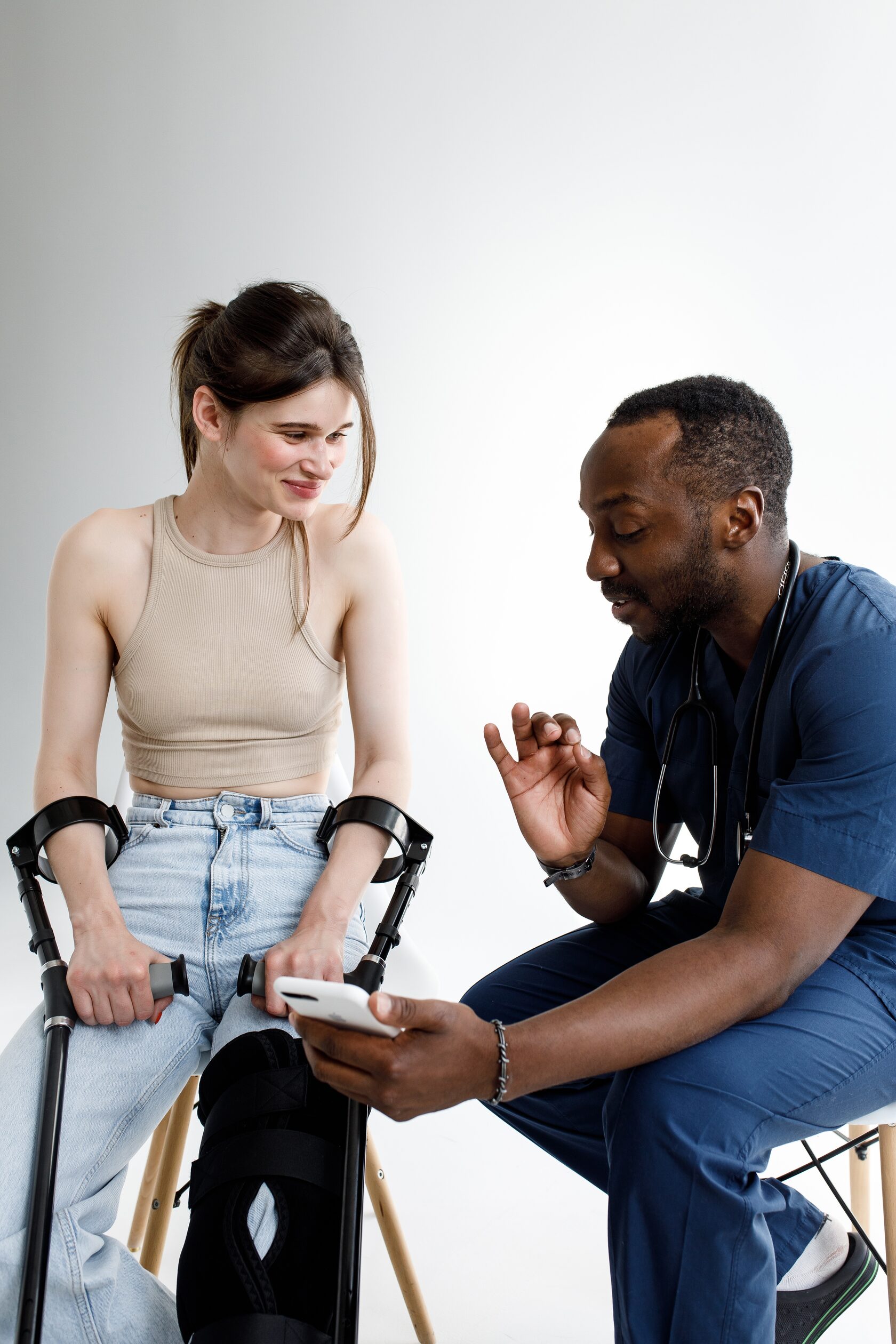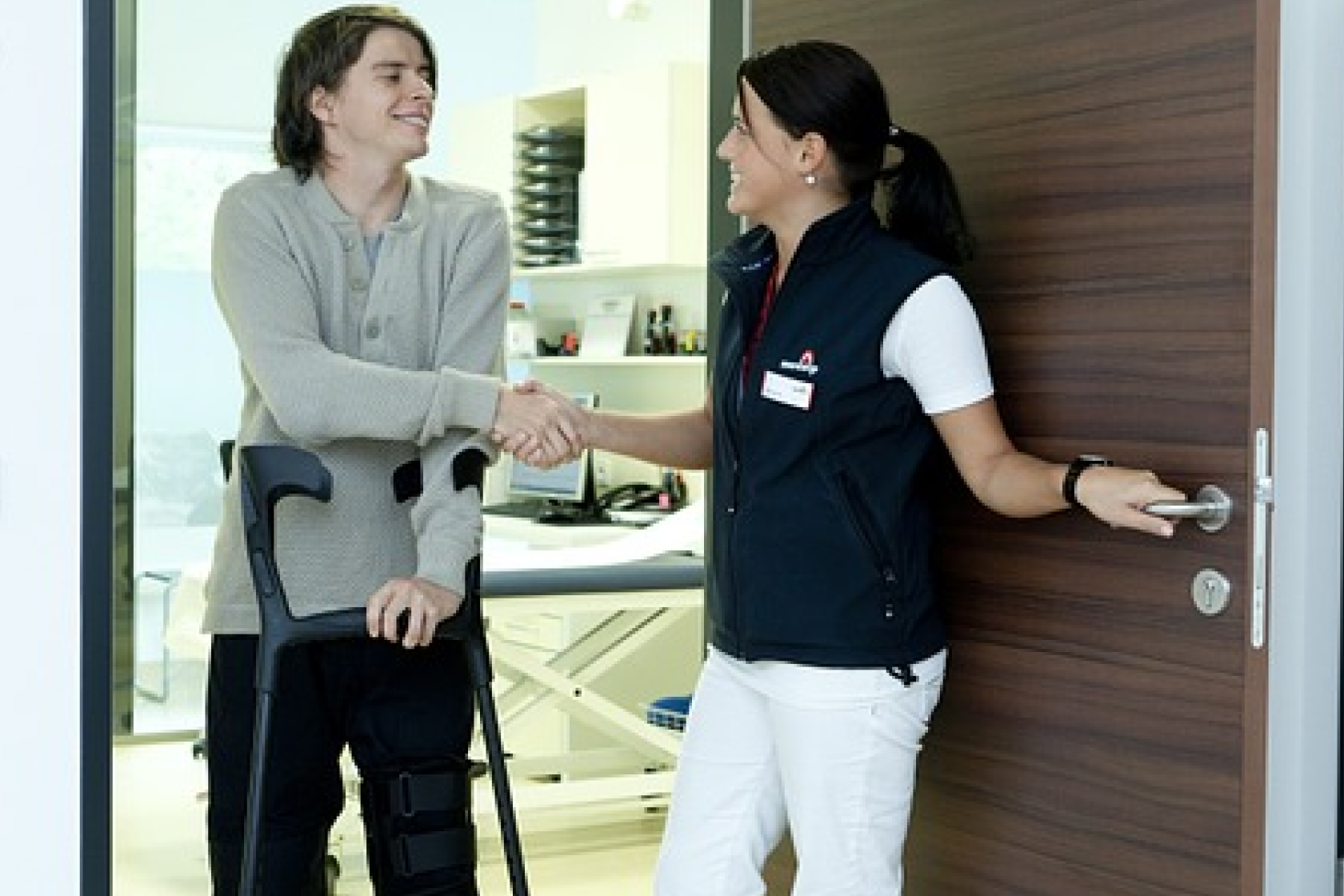Now what if there was an objective measure for tracking patient WB compliance throughout the rehabilitation process?
Physical therapists are tasked to teach patients gait training with an assistive device and to instruct them in their prescribed weight-bearing (WB) status after an injury or surgery.
The process involves using an objective measure such as scales to show the patient the allowed WB load. Then through neuromuscular and proprioception training, or skilled muscle memory exercises, the patients internalize that measure and apply it to crutch walking. This muscle memory, a subjective measure, is the keystone to patient WB compliance.
Now what if there was an objective measure for tracking patient WB compliance throughout the rehabilitation process?

Physical therapists are tasked to teach patients gait training with an assistive device and to instruct them in their prescribed weight-bearing (WB) status after an injury or surgery.
The process involves using an objective measure such as scales to show the patient the allowed WB load. Then through neuromuscular and proprioception training, or skilled muscle memory exercises, the patients internalize that measure and apply it to crutch walking. This muscle memory, a subjective measure, is the keystone to patient WB compliance.
Now what if there was an objective measure for tracking patient WB compliance throughout the rehabilitation process?

Presented will be static and dynamic methods to measure WB on an injured leg. The second dynamic method provides objective WB data throughout the gait rehabilitation process.
Static Method of Teaching WB
Dual-scale method





The first method of teaching WB to a patient is a dual-scale method. It is aimed to measure the static pressure made by each leg while standing upright and still on the scales.[1,Fig1]
This method is easy to understand and perform repetitively at home. The patient stands on one scale with will all his body weight on the healthy leg. Then slowly he places the injured, or involved leg, on the other scale. Progressively the patient shifts his weight onto the involved leg reaching the prescribed weight onto the involved leg.
The weight shifting can occur side to side, front to back, and back to front mimicking the transfer of weight when walking. This exercise is repeated in variations of looking at the scale as you shift the weight, and then by shifting the weight onto the scale without looking and verifying the amount achieved.
When the patient begins using this method as part of his home exercise program, it is recommended that another person is present to watch the scale and tell the patient when he is exceeding the allowed weight. This is especially necessary with a toe touch weight-bearing prescription and partial weight-bearing prescription.
The dual-scale method has its flaws





– Firstly, static loads do not adequately represent gait weight-bearing.[1]
– Secondly, depending on a patient’s health condition, it is not always possible to measure static loads properly.[1]
– Thirdly, it takes time to develop the muscle memory for a particular weight-bearing status.
The only way to verify you have an accurate muscle memory is by using scales, which is not feasible in an activities of daily living such as walking and stair climbing. According to researchers, “while patients may have a sense of weight in lifting objects, they do not share that same weight sense of weight borne over an extremity”.[2]
As a result, referring to dual-scale measurement and memorized feeling of loads, patients tend to exceed recommended partial weight-bearing by 27-35%.[3]
Dynamic Method of Teaching WB
Dynamic assessment of weight-bearing using a force platform





The second method of teaching WB to a patient is the force platform. The force platform measures the dynamic loading on the injured leg while walking. This method provides an analysis of loading throughout the gait cycle.[1,Fig2]
A healthcare professional has the patient walk with crutches across the force plate keeping to the WB restriction learned earlier in a static position. Cues are given to help the patient achieve the prescribed WB status in walking. The gait data provides information about the patient’s WB compliance level. The force plate training applies WB to a functional activity of daily living.
Nevertheless, this method has the same shortcoming as the dual-scale static loading measurement. Specifically, it is difficult to memorize the proper weight-bearing and, then, apply it to crutch walking in your daily life.[1]
Furthermore, while you can use the dual-scale method as a home exercise for reinforcing the WB status, you probably do not have access to a force platform at home. It means that this kind of weight assessment during a gait can be done only during an appointment with a healthcare professional.
ComeBack Mobility Smart Crutch Tips





The third method of teaching WB to a patient is the ComeBack Mobility Weight-Bearing tracking system. The ComeBack Mobility system is comprised of Smart Crutch Tips and corresponding Patient and Doctor App. The Smart Crutch Tips track a patient’s WB during crutch walking and provide real time visual, audio, and vibration feedback to inform the patient when the injured leg is being overloaded.
The Patient App stores gait data such as the WB compliance data and step count. It also provides the vibration notification when WB is exceeded on the injured leg. The Doctor App and dashboard provide telehealth capabilities to patient care. They receive real time gait data from their ambulating patient and can evaluate their progress. If concerning WB trends are seen in the data, the rehabilitation team can contact the patient and provide guidance to ensure a steady recovery without complications.
The true benefit of this system is its dynamic nature and functional application in real life. The patient always has the crutches with him, always receives WB feedback, thus is constantly improving compliance to the prescribed WB status. This decreases the risk of complications and improves the rate of recovery.
Presently the Smart Crutch Tip technology rises above the downsides of the dual- scale method and the force platform. The Crutch tips are dynamic, functional, and constantly providing feedback to the patient. At this moment, the downside of the Smart Crutch Tips system has yet to be identified. The Smart Crutch Tips and Apps are a reliable and valid way to maintain proper weight-bearing during crutch walking.
No matter what method is used to teach proper weight-bearing after an injury or surgery, the matter stands that it is a necessary task requiring the patient to have patience, diligence, and awareness of the body.

The true benefit of this system is its dynamic nature and functional application in real life. The patient always has the crutches with him, always receives WB feedback, thus is constantly improving compliance to the prescribed WB status. This decreases the risk of complications and improves the rate of recovery.
Presently the Smart Crutch Tip technology rises above the downsides of the dual- scale method and the force platform. The Crutch tips are dynamic, functional, and constantly providing feedback to the patient. At this moment, the downside of the Smart Crutch Tips system has yet to be identified. The Smart Crutch Tips and Apps are a reliable and valid way to maintain proper weight-bearing during crutch walking.
No matter what method is used to teach proper weight-bearing after an injury or surgery, the matter stands that it is a necessary task requiring the patient to have patience, diligence, and awareness of the body.

The algorithm subtracts the peak load from the crutches from the patient’s weight – thereby obtaining data on the load on the injured limb. The smart crutch tip’s margin of error is less than 100 grams
The smart crutch tips tell the patient in real time how they are loading the involved leg. If the patient is not at the prescribed weight bearing (WB) status, they will receive audio, visual, or vibration cues to correct their WB load
The big advantage of smart crutch tips is that they are mobile and affordable to the consumer. They can also be used everywhere! The main thing is not to forget crutches 🙂
SOURCES
- Patient compliance with touchdown weight bearing after microfracture treatment of talar osteochondral lesions
- Patient compliance with postoperative lower extremity touch-down weight-bearing orders at a level I academic trauma center
- (PDF) Weight Bearing Compliance after Foot and Ankle Surgery
- Factors Affecting Compliance With Weight-Bearing Restriction and the Amount of Weight-Bearing in the Elderly With Femur or Pelvic Fractures
- Application Of Calculating The Maximum Permissible Load On The Femur After Osteosynthesis
- Current advances in training orthopaedic patients to comply with PWB instructions
- Force Plates – Do you need one?
- Different in-shoe devices for partial weight bearing
- Effectiveness of a Simple Auditory Feedback Insole






